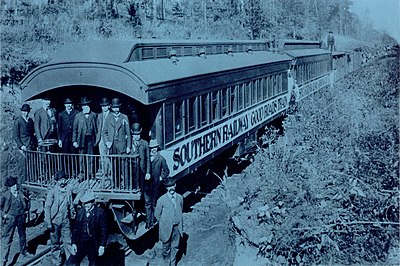the rural districts and wishes to help the farmers and others to get good roads. Therefore, the Department of Agriculture has established the Office of Road Inquiry, which is seeking to gather all the information possible about the construction and maintenance of good roads and to impart it gratis to the people. The government will not build your roads, but will place at your disposal all the information it has gained from experts, experiments and other sources. . . .
‘Here we have not even built the best kind of macadam road. For that you must go to your cities and look at the boulevards. We have simply taken the material at hand and from it constructed the best road possible with the money we have. The boulders from which the stone is crushed were brought from the neighboring farms. They are of good quality and very hard. They consist of granite, trap, syenite, quartz, etc. This is much better than your soft limestone, or loose sandy, washed gravel.’[1]
After 1903, with a tripled budget, the OPEI was able to keep four demonstration teams in the field. Also, with Page’s new laboratory in operation, the Government undertook to test the materials going into the object lesson roads without charge to the local cooperators, eliminating guesswork in this very important aspect of roadbuilding.
The Good Roads Trains
In 1893 there was only one national good roads organization in the United States and three or four local associations. Eight years later there were over 100 organizations promoting good roads, including six distinctly national road associations. In 1901 the most active and aggressive of these organizations was the National Good Eoads Association (NGEA) which had been formed during the Chicago Good Roads Convention of 1900, and was headed by Colonel William H. Moore of St. Louis as president and Colonel R. W. Richardson of Omaha as secretary. Like many other good roads organizations, the National Good Roads Association had no permanent membership list and depended for its support on donations from civic groups, manufacturers of road machinery, suppliers of road materials, wealthy individuals, the public at large and even the railroads.

The Southern Railway Good Roads Train with some of the road experts during its fall trip in 1901.
Colonel Moore, the guiding spirit of the NGRA, was a skillful and persuasive promoter, with a wide acquaintanceship among influential people. In 1901 he conceived the idea of a traveling good roads show that would cover the country, educating the public on the advantages of improved highways, very much in the manner of the circuses and the popular Chautauqua shows. He persuaded the road machinery companies to help with this project by donating their latest models, along with trained operators, to run them. From the Illinois Central Railroad, he obtained the promise of an 11-car train free of charge, to transport the show from place to place. Finally, he approached Director Dodge to give Government sanction to the idea by providing a road expert to lecture on roads and supervise demonstrations of roadbuilding. Dodge was unable to help because his budget was already committed to other work; however, when the Associa-
48
- ↑ Gen. Harrison Tells How the Road Was Built, The Road Maker, Vol. 1, No. 3, (Port Huron, Mich.) p. 6.
